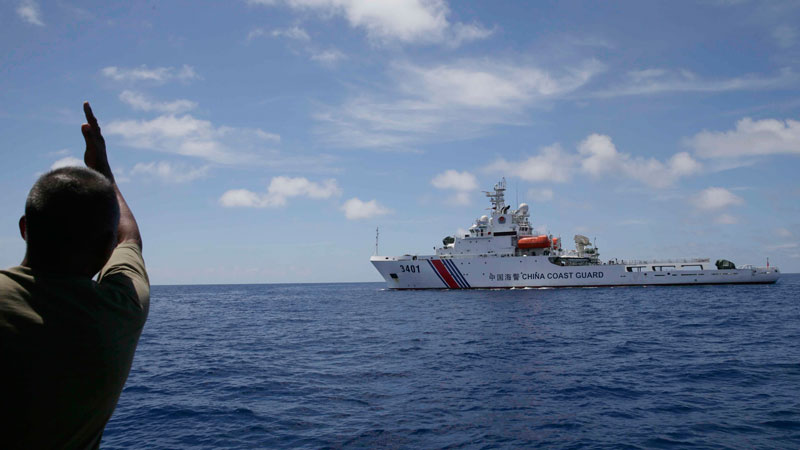
A Philippine Marine gestures at a Chinese Coast Guard vessel which tries to block a Philippine Government vessel AM700 from approaching the Second Thomas Shoal (local name Ayungin Shoal) to resupply and replace fellow marines who were deployed for almost five months Saturday, March 29, 2014 off South China Sea on the West Philippine Sea. Chinese coast guard ships set up a blockade but a lone Philippine boat maneuvered past them in the high seas Saturday to deliver a fresh batch of Filipino troops and food supplies to a disputed shoal in a tense, cat-and-mouse-like confrontation witnessed for the first time by journalists in the South China Sea. AP
(Editor’s Note: Inquirer reporter Nikko Dizon and photographer Grig Montegrande were with a group of journalists who were invited by the military to accompany a resupply mission to Filipino soldiers stationed at the grounded BRP Sierra Madre on the disputed Ayungin Shoal. What follows is Dizon’s account of a tense nearly two-hour standoff.)
AYUNGIN SHOAL, 1:17 P.M. (Saturday)—We are being harassed by the Chinese Coast Guard. There are two Chinese ships, with bow numbers CCG 3401 and CCG 1127, and “China Coast Guard” markings on their hulls.
We are on board a Bureau of Fisheries and Aquatic Resources (BFAR) research vessel manned by four Philippine Navy officers and 20 enlisted personnel in civilian clothes. With us are a fresh batch of Marines that will replace the contingent at Ayungin Shoal. There are 18 journalists, 10 on the BFAR ship and 8 in a small motor boat.
The trip is significant because it comes on the eve of the filing by the Philippines of a memorial, or memorandum, detailing its case against China with a United Nations arbitral tribunal.
At 1:17 p.m., the first call from the Chinese Coast Guard 3401, to our ship comes: “Please identify yourself.”
We were 10.3 kilometers northeast of Ayungin Shoal. We can see the BRP Sierra Madre as a small figure in the distance.
Lt. SG Ferdinand Gato, 47, the head of the mission, replies: “This is [a] Republic of the Philippines ship. This is a civilian government vessel.”
There is a long pause.
Gato calls back: “Charlie Charlie Golf 3401.”
The Chinese reply: “Your vessel has entered the sea area under the jurisdiction of China. May I know what is the purpose of your entering the sea area?”
Gato says: “We are proceeding to reprovision our vessel.”
There are several more exchanges. The Chinese Coast Guard says: “You will face full responsibility for your actions.”
Lt. JG Sherwin Bulahan, the ship captain, 32, and his crew who are all on the bridge at this time, are monitoring the movement of the Chinese ships.
Right of way
The Chinese ship, which is on our port (or left) side, starts blowing its horn, telling us to leave. It then maneuvers and crosses our path, continuously blaring its horn. The ship goes to our starboard, or right, side, then moves again to cross our path. We slow down and then stop. The Chinese ship then goes back to our left side. We are maintaining our original course but we veer to the left.
Gato explains to the journalists: “We had the right of way according to the international maritime rules. We can see their starboard which means green, we are go.”
Then Gato starts steering toward a shallow part of the shoal.
Blockade evaded
The Chinese ships cannot follow to the shallow part because their ships are too big. The BFAR boat is 31 meters long; the Chinese ships are thrice as big.
By 2:13 p.m., when we manage to put some distance from the Chinese. The Navy personnel hoists a tiny Philippine flag on the mast of the ship. We all start cheering.
But when the Chinese ships were blocking our path, I was almost close to tears. It felt like a David versus Goliath moment.
Still, while all this was happening, we could see several planes flying above us, nationality undetermined. We had a feeling our friends were watching over us.
‘This is ours’
By 2:26 p.m., we enter one of the entry points to Ayungin Shoal and we can see the Marines on Sierra Madre waving to us.
Marine Technical Sgt. Jerry Fuentes, 50, who is on his second deployment to Ayungin, is sitting on a bench watching the Chinese ships. I ask him how he feels.
“It makes us even tougher. In the first place, this is ours, why should we leave?” he says.
Marine Technical Sgt. Albert Villanueva, 45, has his mind set on staying for four to five months at Ayungin (the normal tour of duty is three months). He says he has missed his eldest child’s graduation and youngest daughter’s sixth birthday.
By 3:02 p.m., we are beside LST (landing ship transport) 57, the code name of the BRP Sierra Madre.
At 5:47 p.m., the soldiers are loading the provisions to BRP Sierra Madre using a pulley.
‘Enjoying what’s ours’
The mood is celebratory. After all, we traveled at sea for 36 hours and 30 minutes, sailing from our jump-off point somewhere near Puerto Princesa at 3 a.m. last Friday.
The journalists were divided into two groups—10 in the BFAR ship and eight in a motor boat.
In the horizon, I can still see the two Chinese ships, one to our right and another straight ahead, staring at us.
As the sun sets, I will jump into the green waters of the shoal and enjoy what is ours.
RELATED STORIES
Chinese coast guard harassing PH ship at Ayungin Shoal
Reporter and officer: Call her ‘ma’am,’ then salute